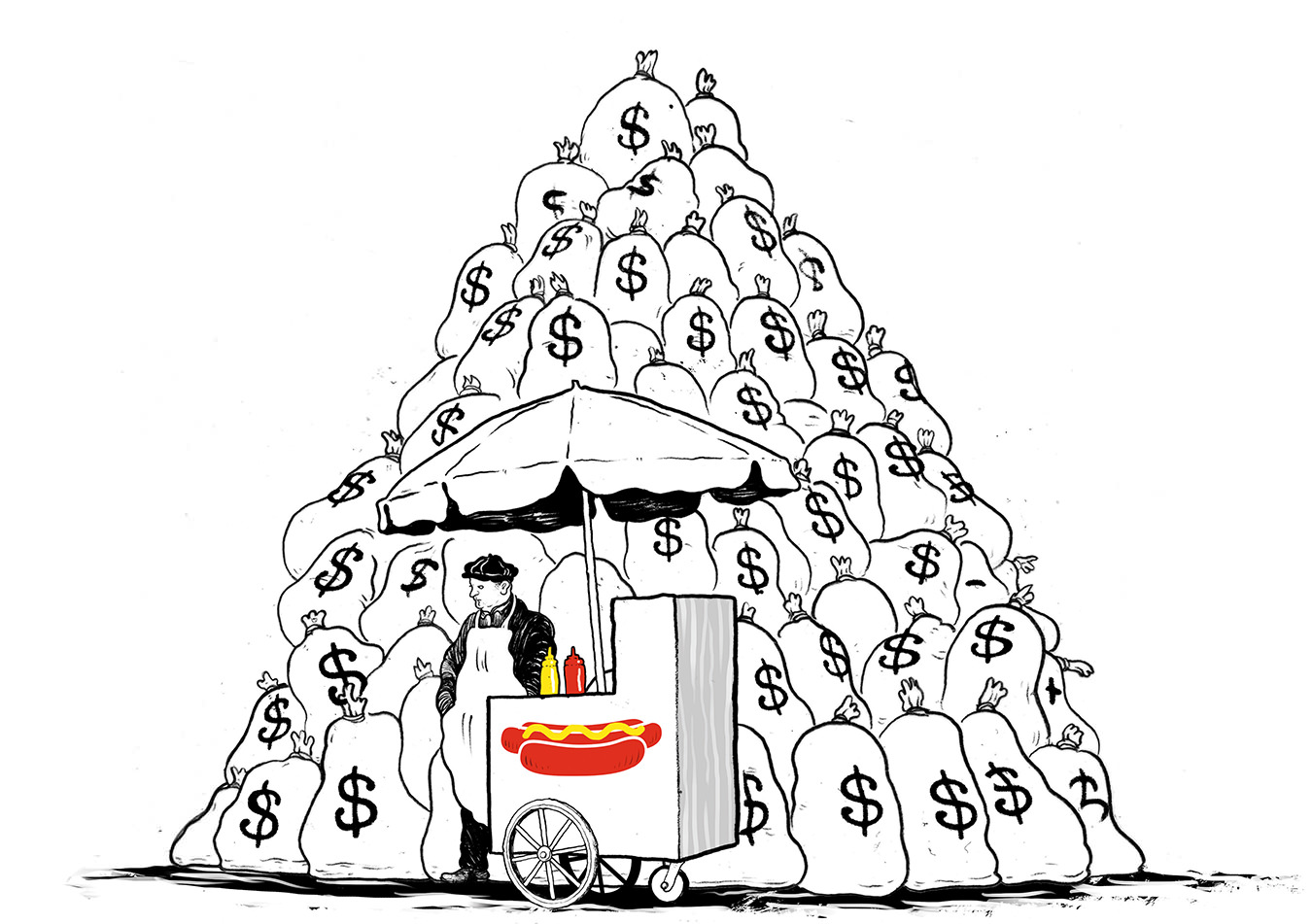The Bond Market
Bonds go bust.

Iillustration by David Foldvari.
And so it has come to this. On July 16, 2012, yield on the benchmark 10-year Government of Canada bond hit a low of 1.61 per cent. Core inflation for June (the most recent month for which data are available): 2.30 per cent. The difference: negative 0.69 per cent.
Ponder that for a moment. People invest for many reasons, but at the foundation of them all is the expectation of your investment appreciating over time; to get more money out of the effort than you put in. Someone has apparently forgotten to pass the memo on to bond investors. Once the loss of purchasing power (inflation) is factored in, Canadian bond investors are now willingly socking their money away for the express purpose of getting less of it in a decade.
They have plenty of company in such misery. Bond investors south of the border have been in a similar situation for most of this year, with 10-year government yields recently touching an all-time low of 1.46 per cent. Meanwhile, across the pond, investors in most of the stable European economies (Germany, Finland, and the Netherlands, among others) are actually experiencing negative yields on short-term bonds: instead of the government paying them interest, investors are paying the government interest for the privilege of buying a bond.
What happened? In a word: fear. And plenty of it. Since the collapse of Lehman Brothers back in 2008, investors have run away from risk in all its forms, but particularly that which resides in the stock market. In such an environment, the guarantee of principal that is a core feature of bonds has become a very hot commodity. The equation is simple: as volatility continues, demand for bonds goes up. As demand goes up, so does the price. And as the price goes up, the yield—interest paid (coupon) divided by price paid—goes down. A lot.
To anyone who uses bonds as the cornerstone of their financial plans, the news doesn’t get any worse than this. The certainty of bonds producing income (however meagre) has always formed the basis of long-term asset allocation decisions for retirees, pension funds, life insurance companies, or anyone living off the income generated by their investment portfolios. Now such investors are forced to adapt to a new reality: whatever income they receive in the here-and-now may well be unable to offset the loss of purchasing power on their bonds when they receive their principal back.
Yet there seem few obvious alternatives—at least for those investors who put a premium on avoiding risk. Equities: volatile. Real estate: uncertain in Canada; even more so in the United States. Hedge funds and other alternative strategies: discredited in the recent financial crisis. Gold and silver: after a tremendous run-up last year, both have come back down to earth. Oil, copper, potash, pork bellies, and other commodities: might as well take your money to the roulette table.
And here we are: gut-check time for bond investors. In the wake of the most challenging environment for bonds in a generation, do bond investors stick to what’s worked in the past? Or do they go looking for income elsewhere? If so, where? In times like these, where exactly should security-minded investors put their money?
Safety No More?
One person who has spent a good deal of time trying to answer such question is Robert Pemberton, a managing director and head of fixed income at TD Asset Management. He recently headed up a team that carried off its second Morningstar Fixed Income Manager of the Year award in a row, and Pemberton is well aware of how the current low-yield environment has wreaked havoc with asset allocation assumptions and has shaken the faith of those who have built their portfolios around the perceived safety of government bonds.
While Pemberton notes that tough times aren’t entirely unprecedented in the bond market, he acknowledges that the current climate is a dramatic change from the recent past. “If we think about the past 20 to 30 years, fixed income investors had the benefit of both their coupon returns and their capital gains,” Pemberton points out. “Today, the likelihood of those outsized capital gains that we’ve seen in the past is greatly diminished. And the income that investors currently receive off their coupon flow is much smaller than in the past.”
Net result: a heads-you-lose, tails-they-win scenario, at least when it comes to government bonds in the so-called developed world. “We see sovereign debt—government of Canada, the U.S., to a certain extent the U.K. and Germany—as being very much challenged to provide investors with a real return over the next five years.”
The root cause of the problem? “The volatility of the 2008 financial crisis really rocked consumer and investor confidence,” Pemberton answers. “Whenever investors are uncertain, they seek safety at the expense of return—a return of capital rather than a return on capital. The sheer amount of money chasing safety and the vast amount of money the central banks have put into the global financial system has helped drive bond prices up and consequently yields down.”
Today, four years after the stock market blow-up, we see the result of that “safety first” mentality in the bond markets of the developed world. “Worried investors are piling into government securities—U.S., United Kingdom, Germany, Japan, etc.—because they perceive they are ‘safe,’ ” he says. As Pemberton notes, the irony is that in their search for safety, such investors may be simply trading one risk for another. “Moving forward, bonds may be less volatile than equities. However, with low yields, they currently offer little income or protection from inflation.”
Bad news, to be sure. But what’s worse is the likelihood that the current situation will be with us for awhile. “Debt levels in the major developed markets have reached the point where economic growth going forward will be low and consequently investment returns will be low as a result,” Pemberton says. “Persistent slow growth implies persistent low returns for an extended period of time.”
How long will that be? That depends on a number of macroeconomic developments. “Actions that promote productive growth and boost confidence are key,” Pemberton says. “In the near term, we believe investor confidence will be helped if Europe can have meaningful solutions put in place that improve the level of debt to income, if there are signs out of China that economic growth is rebounding, and if the U.S. political leadership can provide confidence that they will get their fiscal house in order.”
Of course, when that will come to pass is quite another question. “One key macro-factor is the fiscal imbalance faced by many governments,” he notes. “This requires significant political will to resolve. As such, we expect this will take considerable time to resolve.”
Best of a Bad Situation
For investors wondering what the gloomy outlook means to their bond portfolios, Pemberton acknowledges that there are no easy answers. If anything, he believes that now is the time for investors to understand what they hope to accomplish with their portfolios. “Investors will be best served by focusing on three key things,” he says. “What outcomes are they trying to achieve? What is their time horizon? What are their true risk tolerances? Investors [need] to consider the role of fixed income in their portfolio.”
From a tactical perspective, Pemberton believes bond investors need to recognize the “new normal” forming in the bond markets, one that should have interest rates lower for longer. “The past 20 years is not reflective of what you’ll see for returns in the next five-to-seven [years] from the fixed income markets,” he says. “When you [consider] a broad portfolio, investors should be looking at opportunities to generate income outside of the pure fixed income marketplace.”
As for what those other opportunities may look like, Pemberton has several suggestions. “Opportunity presents itself in many ways,” he says. He and his team have been taking a closer look at a number of ideas including (perhaps surprisingly for a fixed-income specialist) dividend-producing stock. “High-quality dividend paying equities offer lower volatility than the broader marketplace, and stability of income which will also provide a certain amount of inflation protection over time.”
For those who remain focused on bonds, Pemberton suggests taking a look at corporate bonds—both the investment-grade and high-yield markets offer an attractive alternative for those willing to take on a little more risk. “Corporations have been very conservative in the past five-to-seven years with their balance sheets and how they fund themselves,” Pemberton notes. However, he cautions investors that such investments demand more scrutiny than the “set-it-and-forget-it” attitude that many investors take when purchasing government bonds. “Simply accepting an ETF [exchange-traded fund] basket of securities which replicates a benchmark or index may introduce risks that investors are uncomfortable with—or unaware they are taking.”
While bonds from countries such as China, South Korea, Brazil, South Africa, and other emerging market economies have received a good deal of press lately, Pemberton is less enthusiastic. “Practically speaking, [the] markets are still developing and liquidity can be low,” he says. While some analysts and market pundits see emerging market bonds as an excellent way to diversify and boost yields, Pemberton notes that much of the extra yield can be eaten up in currency fluctuations and transaction fees. “The challenge for investors is to gain exposure in a way that will still produce positive real returns. We find high-yield bonds in the U.S. to provide a more attractive risk return tradeoff than EM at the moment.”
As for selling bonds “short” as a way of profiting from their anticipated fall in price, Pemberton believes those who want to pursue that game should be honest with themselves about the risks involved. “ ‘Shorting’ a stock or bond is a fundamentally different form of investment strategy,” he asserts. “Anyone who chooses to be aggressive in this area needs to be aware of this: timing is key.”




